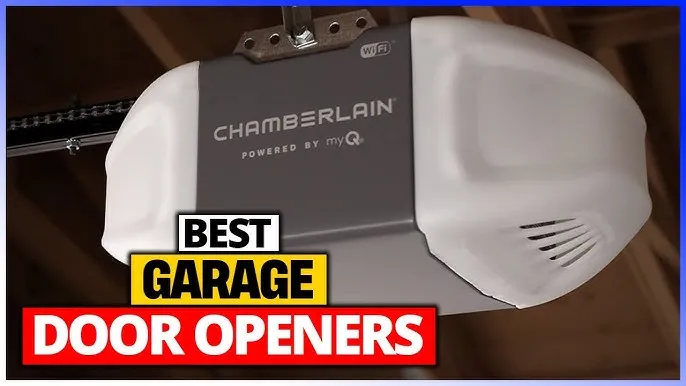Garage door openers have become a standard feature in many homes, providing convenience, security, and ease of access. If you’re considering installing a garage door opener yourself, you’re in for a rewarding DIY project. With the right tools, a bit of technical know-how, and a systematic approach, you can save money and have the satisfaction of completing the job yourself. In this article, we’ll provide you with essential tips and tricks to ensure a successful DIY garage door opener installation.
1. Choose the Right Garage Door Opener
Before you start your DIY installation, it’s crucial to choose the right garage door opener for your needs. Consider factors such as the size and weight of your garage door, the level of noise you can tolerate, and any additional features you desire. Garage door openers come in various types, including chain drive, belt drive, screw drive, and direct drive. Each type has its advantages and disadvantages, so select the one that best suits your preferences and budget.
2. Gather the Necessary Tools and Materials
To successfully install a garage door opener, you’ll need the following tools and materials:
- Garage door opener kit (including the opener unit, rail, and accessories)
- Screwdrivers (Phillips and flathead)
- Adjustable wrench
- Socket and ratchet set
- Level
- Tape measure
- Pliers
- Wire stripper and crimper
- Drill and drill bits
- Ladder
- Safety goggles
- Work gloves
- Power outlet and extension cord (if not already available in the garage)
Having the right tools on hand will make the installation process smoother and more efficient.
3. Read the Installation Manual
The installation manual provided with your garage door opener is your best friend during this project. Before you start, thoroughly read and understand the manual’s instructions. It will guide you through the installation steps, provide essential safety information, and offer troubleshooting tips if you encounter any issues. Make sure to keep the manual accessible throughout the installation process for easy reference.
4. Safety First
Safety should be your top priority when installing a garage door opener. Be sure to take the following precautions:
- Disconnect the power: Before starting any work, disconnect the power to the garage door opener by unplugging it or turning off the circuit breaker. This will prevent accidental activation while you’re working on the installation.
- Use safety gear: Wear safety goggles to protect your eyes and work gloves to prevent injuries while handling the components.
- Stay clear of moving parts: Be cautious around the moving parts of the garage door opener. Keep your hands and clothing away from the belt, chain, or screw drive mechanism while it’s in operation.
- Secure the ladder: If you need a ladder to access certain parts of the installation, ensure it’s stable and positioned on a level surface.
5. Prepare the Garage Door
Before installing the garage door opener, make sure your garage door is in good working condition. Check for any signs of damage, such as dents, cracks, or loose hardware, and address these issues first. Ensure that the door is balanced and moves smoothly along its tracks.
6. Assemble the Opener Unit
Follow the manufacturer’s instructions to assemble the garage door opener unit. This typically involves attaching the motor unit to the rail and installing the drive mechanism, such as a chain or belt. Ensure all connections are secure and tighten any loose bolts or nuts.
7. Mount the Opener Unit
With the opener unit assembled, it’s time to mount it to the ceiling or wall of your garage. Use a level to ensure that it’s installed perfectly horizontal or vertical, depending on the manufacturer’s instructions. Secure it in place with sturdy brackets and bolts.
8. Install the Rail
Next, install the rail along the ceiling or wall, depending on your chosen garage door opener type. The rail serves as the track for the trolley that moves the garage door. Make sure the rail is level and securely fastened. Attach the trolley to the rail according to the manufacturer’s instructions.
9. Attach the Trolley to the Door
Connect the trolley to the garage door using the provided hardware. It’s crucial to follow the manufacturer’s instructions precisely to ensure the trolley is properly aligned with the door and operates smoothly.
10. Wire the Opener
Wiring the garage door opener involves connecting the control wires to the opener unit, safety sensors, wall control panel, and any other accessories included with the kit. Follow the color-coded wiring diagram provided in the installation manual to ensure correct connections. Use wire strippers and crimpers to make secure connections and eliminate any exposed wires.
11. Install the Safety Sensors
Most modern garage door openers come with safety sensors that prevent the door from closing if an object or person is in its path. These sensors are typically installed near the bottom of the door tracks. Ensure they are aligned properly, facing each other, and securely fastened.
12. Program the Remote Controls
After wiring and sensor installation, it’s time to program the remote controls that come with your garage door opener. Follow the manual’s instructions to sync the remote controls with the opener unit. If your opener is compatible with a smartphone app or other smart home systems, set up those features as well.
13. Test the System
Before considering the installation complete, thoroughly test the garage door opener. Ensure that the door opens and closes smoothly and that the safety sensors work correctly by obstructing the door’s path during closing. Test the remote controls, wall control panel, and any additional features you’ve set up.
14. Adjust the Opener Settings
Most garage door openers allow you to adjust settings such as the force required to open and close the door and the travel limits. Consult your manual to make these adjustments if necessary to ensure the door operates smoothly and safely.
15. Lubricate Moving Parts
To maintain the long-term performance of your garage door opener, it’s essential to keep moving parts lubricated. Use a suitable garage door lubricant on the chain, belt, or screw drive mechanism as recommended in the manual.
16. Secure All Hardware
Check all bolts, nuts, and fasteners to ensure they are tightened securely. Loose hardware can cause noise, vibrations, and even damage to the garage door opener over time.
17. Keep the Manual and Warranty Information
Finally, retain the installation manual, warranty information, and any documentation related to your garage door opener in a safe place. This will be valuable if you need to reference the manual for maintenance or if you ever need to make a warranty claim.
Conclusion
A DIY garage door opener installation can be a rewarding project that saves you money and gives you a sense of accomplishment. By following these tips and tricks and carefully reading the manufacturer’s instructions, you can complete the installation safely and efficiently. However, if you’re uncomfortable with any part of the process or encounter unexpected challenges, don’t hesitate to seek professional help. The safety and functionality of your garage door opener are essential, and it’s better to have a professional technician step in if needed. With the right approach and attention to detail, you can enjoy the convenience and security of a well-installed garage door opener for years to come.














